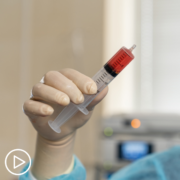Do AML Bone Marrow Biopsies Show Racial and Ethnic Variances?
Do AML Bone Marrow Biopsies Show Racial and Ethnic Variances? from Patient Empowerment Network on Vimeo.
Are racial and ethnic differences shown in acute myeloid leukemia (AML) bone marrow biopsies? Expert Dr. Andrew Hantel from Dana-Farber Cancer Institute and Harvard Medical School discusses what early AML studies are showing and proactive patient advice for bone marrow biopsies.
[ACT]IVATION TIP
“…ask your doctor about what the different things that they’re looking for in the bone marrow biopsy are and kind of what they mean to you. Sometimes, they can be looking to see if the leukemia has cleared after a treatment. Sometimes, they’re looking to see if there’s a change in the mutations that they saw before in your leukemia and are seeing if you know something is different than they can now target.”
Download Resource Guide | Descargar guía de recursos
Related Resources:

Novel AML Therapy Use | Impact of Socioeconomic Status and Other Factors |

How Bone Marrow Biopsies Impact Acute Myeloid Leukemia Treatment and Care |

|
Transcript:
Lisa Hatfield:
With these bone marrow biopsies or the disease in general, AML in general, do you see any unique patterns with different racial or ethnic groups? Because we see so many disparities in healthcare, any way in that you see different patterns of maybe genetic mutations with AML or any differences in the general course of the disease?
Dr. Andrew Hantel:
I would say that we…there are hints of those things right now. So there are some early studies that are showing, there are a couple specific mutations that have either increased rates or decreased rates in different racial and ethnic groups. The extent to which any of those have been really done on a wide scale and also done to the extent that we can say it actually makes a difference in different groups’ outcomes we haven’t established yet. And so right now, it’s more just hints that something is a little bit different. But the extent to which that is actually changing the course of somebodies diseases hasn’t been established. And it seems like some of these changes aren’t necessarily in the same mutations that we think of as having a lot of significance in terms of altering somebody’s prognosis.
And so while it may be activating slightly different pathways, they aren’t the ones that are, we think in our mind are the most important ones for saying how well or how not well somebody might be doing with their leukemia. There’s a lot more research that is being actively done by my colleagues both at Dana-Farber and nationally to understand that and may come that some of what I just said becomes not true, because there are new findings seen.
And that I hope that we can understand some of those differences and pathways more. But to the extent that anything actionable is done based on those things right now, the answer is no. Right now, we know that anybody can get any of these mutations, and it’s more just that a difference of when we’re looking at a population as a whole, something is a little bit more frequent in one group than another. But that can also come down to who in that group was actually included in the study that we’re doing. And whether or not that exists really across that whole population we have yet to be able to say anything about.
Lisa Hatfield:
Thank you. And do you have an activation tip regarding bone marrow biopsies? And I’ll tell you right now, if you tell patients they might one day not have to have them, they’ll be thrilled, but you don’t have to put that in your activation tip. [chuckle]
Dr. Andrew Hantel:
So my activation tip for this question is, just to ask your doctor about what the different things that they’re looking for in the bone marrow biopsy are and kind of what they mean to you. Sometimes, they can be looking to see if the leukemia has cleared after a treatment. Sometimes, they’re looking to see if there’s a change in the mutations that they saw before in your leukemia and are seeing if you know something is different than they can now target.
And just understanding a little bit more about what their thinking is and how they’re trying to help you by doing the bone marrow biopsy because we…it’s not a test anybody likes to do or have done on them. But we always do it for a good reason, and it’s to make sure that we can better control or better cure leukemia.










